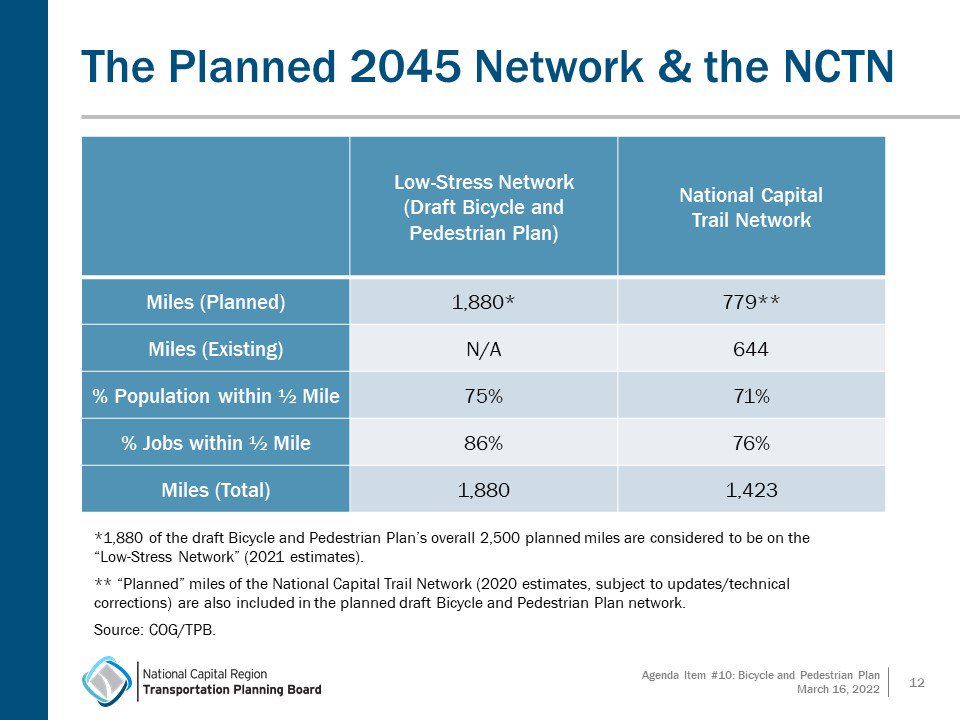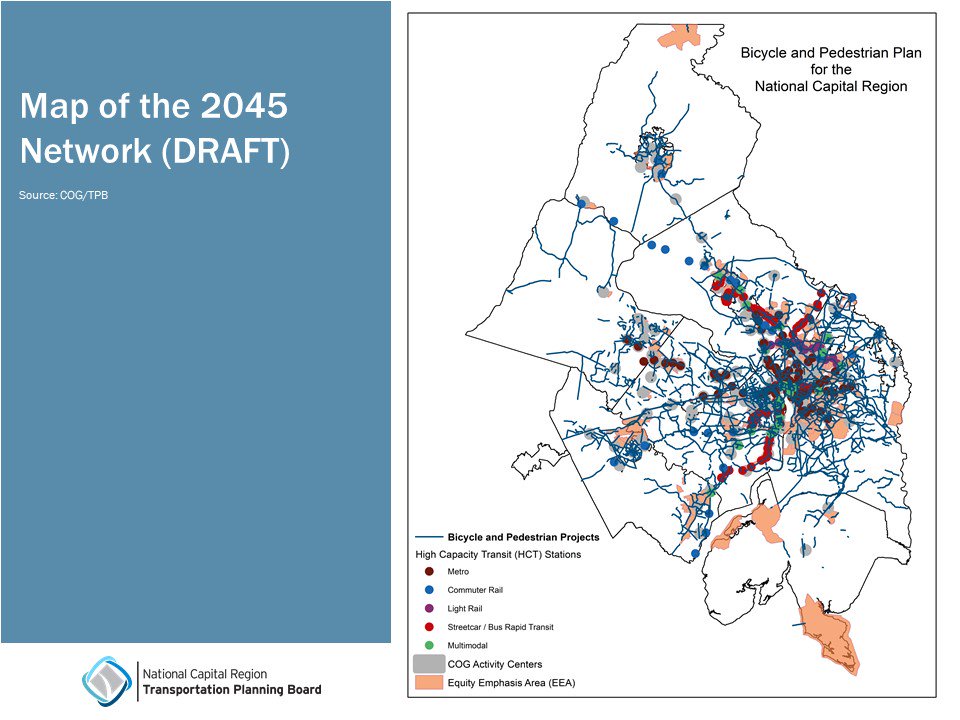TPB board members actively discussed the draft 2022 Bicycle and Pedestrian Plan for the National Capital Region and the Cooperative Forecasting status update. In addition, the TPB members took action on the FY 2023 Unified Planning Work Program (UPWP), FY 2023 Commuter Connections Work Program (CCWP), and 2022 transit asset management (TAM) targets.
Watch the presentations, download item memos, and listen to board discussion.
CHAIR'S REMARKS
Chair Pamela Sebesky encouraged TPB members to share and discuss the climate change and greenhouse gas (GHG) emissions reduction survey (distributed in late February) with staff in their jurisdictions, noting the importance of responses coming from elected officials and city or county staff. TPB will hold a work session on April 20 to discuss survey results and begin crafting a set of strategies that everyone is comfortable adopting.
Sebesky shared the Metropolitan Washington Planning Framework for 2030, a new COG publication, noting that much of the framework is based on TPB’s work on the Aspirational Initiatives of bringing jobs and housing closer together, building transit-oriented communities, developing equity emphasis areas, and expanding the National Capital Trail Network.
“We are all doing this work within our jurisdictions,” she said. “Having a document that brings it all together in an easy-to-understand manner helps us communicate with our stakeholders, the public, and with each other.”
ACTION ITEMS
The TPB adopted four resolutions on March 16:
- Resolution R10-2022 approves an amendment to the current FY 2022 Unified Planning Work Program (UPWP) to carry over funding to the FY 2023 UPWP.
- Resolution R11-2022 approves the final FY 2023 UPWP. Work will begin July 1 with U.S. DOT approval and authorization from the District DOT, Maryland DOT, Virginia DOT, and Virginia DRPT.
- Resolution R12-2022 approves the FY 2023 Commuter Connections Work Program. The annual CCWP identifies alternative commute program projects and services designed to improve traffic congestion and to meet air quality goals.
- Resolution R13-2022 approves the final transit asset management (TAM) targets for percentage of revenue vehicles that have met or exceeded useful life benchmark, percentage of service vehicles that have either met or exceeded their useful life benchmark, percentage of track segments, signals, and systems with performance restrictions (over length of miles), and percentage of passenger and maintenance facilities rated below condition 3 on the condition scale. Learn more about TAM.
INFORMATION ITEMS
Draft 2022 Bicycle and Pedestrian Plan Update for the National Capital Region
Andrew Meese, TPB Program Director for Systems Performance Planning, and Michael Farrell, TPB Transportation Planner, provided a briefing and answered questions about the bicycle and pedestrian plan update, the plan’s integration with the National Capital Trail Network, extended bike lane mileage, safety, Complete Streets and Green Streets initiatives, and emerging technologies such as scooters and e-bikes. The regional bicycle and pedestrian plan was compiled from locally approved bicycle and pedestrian plans. A new feature in the 2022 plan is a 2045 network interactive dashboard for map-based analysis and visualization.
Meese shared several data points from the plan. The percent of trips completed in the District of Columbia by bike increased from 1.6 percent to 5.3 percent from 2008 to 2018. All jurisdictions reporting dates for the two time periods experienced growth in cycling trips. 2,500 miles of facilities and 1,650 projects are included in the 2045 network. Of the total mileage, 1,800 miles are considered “low-stress” (e.g., shared-use paths, protected bicycle lanes, and boulevards), advancing equitable distribution of cycling and walking opportunities.
Network statistics:
- 76% of the population and 87% of the jobs will be within a half mile of low-stress network
- 94% of Activity Centers, 80% of Equity Emphasis Areas, and 86% of Transit Access Focus Areas have a planned bike/pedestrian facility
TPB staff is accepting comments on the draft plan and will prepare a revised draft for the May 18 TPB meeting.

(Source: TPB)

(Source: TPB)
TPB members held an extensive Q&A session with staff about bicycle and pedestrian planning. The first questions focused on the emergence of e-bikes and the rise of pedestrian-oriented activity centers, how equity is interwoven into the regional plan based on local bicycle and pedestrian plans, how microbility is addressed in the plan, and whether local jurisdictions can update the interactive map.
Additional questions covered how the plan relates to TPB technical assistance and funding programs such as the Transportation-Land Use Connections program and Transit Within Reach program, how local initiatives or projects in process are included, what are next steps in bicycle and pedestrian planning, cyclist safety on high-speed roads, and whether walkshed information, walkability scores, and the safety of younger cyclists using on-street facilities can be emphasized or strengthened in the plan.
Listen to the Bicycle and Pedestrian Plan discussion.
Cooperative Forecasting Status Update
Paul DesJardin, COG Director of Community Planning and Services, presented on the Cooperative Forecasts. Cooperative forecasting examines maximum growth for the next 25 to 30 years based on regional econometric model projections for employment, population, households, and local forecasts based on permit applications, local long-range plans, and local comprehensive plans. Round 9.2 forecasts currently used by TPB for 2045 planning reflect a 26 percent increase in jobs, 23 percent growth in population, and a 25 percent increase in households. Change in office vacancy rate is monitored as part of forecasting. Telework preferences indicate generational differences, with younger workers in the 18 to 29-year old range most interested in returning to the office. TPB staff have developed a work plan for Round 10—the next iteration of forecasting which uses 2020 as a base year and 2050 as a planning horizon year. Round 10 will look at short- and long-term effects of COVID-19.
James Walkinshaw, Fairfax County Supervisor, noted that corporate workers who can do their jobs remotely may not be reflected in the statistics presented and determining if there’s a way to capture that data is an important consideration for the next round. Walkinshaw commented that traditional mechanisms for conducting planning forecasting will need to flexible moving forward. Takis Karantonis, Arlington County Board Member, commented that another consideration is whether the short-term tenures of certain employees are reflected in the economic model.
COMMITTEE REPORTS
TPB Technical Committee Report
Matt Arcieri, City of Manassas Director of Planning & Development and TPB Technical Committee Chair, reported on the March 4 meeting. The technical committee agenda included an overview of the draft bicycle and pedestrian plan update and online tools. The committee looks forward to learning more about the bike and pedestrian updates and continuing discussion on the climate change considerations in the Visualize 2045 long-range transportation plan update.
TPB Community Advisory Committee Report
Community Advisory Committee (CAC) Chair Ashley Hutson reported on the March 10 meeting. CAC members were briefed on the draft 9.2 Cooperative Forecasts and posed questions about projected growth, how to figure the number of people per household, and how the jobs increase is calculated. In breakout discussions, CAC members discussed thoughts on in-person CAC meetings and a forthcoming meeting with TPB officers. CAC members would like to meet with TPB officers to discuss pressing issues in the region, plans for using federal infrastructure funding, and how Visualize 2045 aligns with local plans such as moveDC.
Chair Sebesky stated that she has followed up with TPB staff on scheduling a meeting for TPB and CAC members. It’s anticipated that meeting will occur in May or June 2022.
Steering Committee Actions and Director’s Report
Kanti Srikanth, TPB Staff Director, welcomed TPB members back to the COG Board Room and thanked the COG IT staff for their support on implementing and testing technology for virtual meetings over the past two years and for the return of in-person participation.
Maryland DOT and WMATA have submitted Transportation Improvement Program (TIP) amendments related to South Mountain Welcome Center truck parking and adjustments to the WMATA capital budget.
TPB is preparing letters of support for projects receiving funding through U.S. DOT RAISE grants and other U.S. DOT programs in Loudoun and Prince William Counties in Virginia and in Montgomery County, Maryland.
Commuter Connections is welcoming workers back to their offices through a regional “Commute with Confidence” campaign. TPB Chair Pamela Sebesky participated in the February 23 live discussion with Nick Ramfos, Director of Transportation Operations Programs.
Srikanth announced the following activities:
- April 1 is the deadline for returning TPB climate change mitigation questionnaire responses.
- April 1 – May 1 is the 30-day comment period for the draft Visualize 2045 plan update document, the TIP, and the Air Quality Conformity analysis findings. TPB committees will receive briefs.
- April 6 (7:00 - 8:15 P.M.) and April 7 (12:00 - 1:15 P.M.) - TPB will host virtual open houses for the Visualize 2045 plan update.
- April 14 (6:00 - 7:00 P.M.) – TPB will host the virtual TIP Forum in coordination with state DOT and transit agency partners.
- April 8 is the first webinar in the new TPB Transportation Resiliency Planning webinar series. More information will be shared on the COG website and in TPB News.
Kacy Kostiuk, City of Takoma Park Councilmember, stated that there are new opportunities for safety-focused grants available for MPOs through the Bipartisan Infrastructure Law and asked whether work is being done toward a grant that TPB may apply for or may encourage member jurisdictions to apply for in the near future. Srikanth responded that as U.S. DOT releases program guidelines for the new programs, staff will work with the TPB Technical Committee and state DOTs to determine if there are programs to which the MPO could apply. MPOs are now eligible applicants for some programs; there might be opportunities where the MPO can assist local government or state DOTs if TPB comes up with program ideas to complement the local or state applications.
Patrick Wojahn, College Park City Council Mayor, asked if TPB is supporting all the RAISE grant applications in the region or whether some are prioritized. Srikanth replied that TPB supports projects that advance TPB goals and priorities. If a project doesn’t align with those goals, TPB staff will reach out to applicant staff to learn more about the project in order to determine whether to support a particular project.
NEXT MEETING
The April TPB meeting is scheduled for April 20 at 12:00 P.M. A 10:15 A.M. climate work session will be held prior to the meeting.